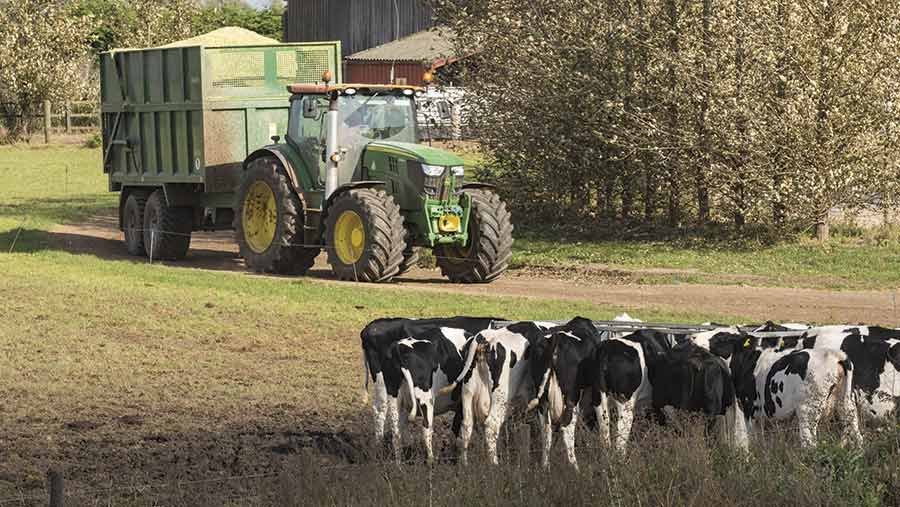Why more livestock farmers are growing maize
 © Tim Scrivener
© Tim Scrivener The UK maize growing area has increased by 14% in five years as the crop continues to gain popularity among livestock producers, a survey suggests.
The survey of 340 farmers was carried out by the Maize Growers Association, British Grassland Society and Grainseed.
It showed the area grown had increased from 12,300ha (30,347 acres) in 2011 to the 14,030ha (34,655 acres) grown by respondents in 2016.
See also: Six step guide to successful maize establishment
And it revealed that, while overall livestock numbers remained static at 66,000 cows and 34,000 beef, the average dairy herd size rose by 13% from 214 to 242 cows. Beef herds had risen by 10% from 165 to 182 head.
Consolidation
Maize grower facts
- 92% achieve yields of 37-50t/ha (15-20t/acre)
- 94% use a consultant
- 62% cite yield reliability as main reason to grow
- 93% feed grass alongside maize
- 24% grow more maize than five years ago
That consolidation is reflected in the expansion in maize growing area on individual farms, which has grown by 37%.
The average maize area per farm is 43ha (107 acres) – compared with 24ha (60 acres) in the first survey of 2007 and 31ha (78 acres) in 2011.
Despite the scaling up in herds it has not been matched by a move to year-round housing with four out of five farms still making use of grazing.
Matt Pickard of Grainseed welcomes that statistic.
“It’s encouraging that despite the size increase, about 80% of herds still have access to grazing with much of the maize growth coming from complementary and buffer feeding while cows are at grass.
“In fact, while 28% of respondents say they have increased the amount of maize fed compared with five years ago, 75% say they use maize all year as a winter and summer buffer feed,” Mr Pickard says.
Fundamental change
The survey picked up that there was a fundamental change in the reason why farmers grew maize.
Previous surveys showed most producers fed maize to boost milk yields.
“Milk yields have risen from 8,094 litres a cow a year in 2007 to 8,796 litres a cow a year now so outright production is still important,” he says.
But the most important advantage identified by growers in 2016 was reliability of forage stocks.
The change was driven in part by a run of poor weather for grass production.
“We’ve had some bad years for grass and silaging with cold and wet summers. And, yet maize production has been relatively stable with good yields, digestibility and energy,” saysMr Pickard.
“So ensuring growers have enough forage to get them through the year has overtaken milk yield in terms of the main reason why people grow maize,” he adds.
Reliability
Reliability of forage production topped the growers list with 62% of people in the survey saying it was the single biggest reason why they now grew maize.
More than 90% of growers said they consistently hit freshweight yields of 37-50t/ha (15-20t/acre) with 52% reporting average yields of 42-50t/ha (17–20t/acre).
Mr Pickard says this was in part due to better varieties, understanding of the crop and overall management levels.
More than nine out of 10 growers (94%) said they now used a professional agronomist.
Pest problems
Few reported significant pest problems, although of the 6% that did, said wireworms, leatherjackets and slugs were the main concern.
A similar number of growers routinely use a fungicide for controlling eyespot but the disease is not seen as a big issue, Mr Pickard says.
By far the biggest pest problem was weeds with 74% responding they had problems.
Half said nightshade caused difficulties, a third had issues with fat hen and 25% said they struggled to combat couch or meadow grass.
Responses to questions on cultivation revealed that 89% still favoured ploughing before seed-bed preparation. Just 8% used minimum-tillage, 2% direct drilled and 1% used strip-tillage.
At harvest one third of growers said they went in at 30% dry matter but only 15% said they routinely sampled for this before cutting. About 57% said they still judged this by eye.
“There’s a range of opinions about optimum chop length with 25% saying 8-12mm, 42% reporting 12-16mm and the remainder favouring longer chop lengths,” says Mr Pickard.
“The chop lengths are a little shorter than expected, but probably reflect the dual use of maize for ruminants and AD.”
When it comes to feeding, the average proportion of maize in the forage rations averaged 51% although 19% fed maize at over 70% inclusion and 11% fed maize as their sole forage source.
Additional feeds
Grass and cereals remained the most important additional feeds.
More than nine out of 10 ( 93%) of livestock producers said grass was fed alongside maize, 56% said cereals and 50% said a proprietary blend.
From there, the order of inclusion runs 42% concentrates, 33% soya, 26% moist feeds, 23% wholecrop, 16% beet and 9% potatoes.
Maize growing survey livestock changes 2011 v 2016 |
|||
|
2011 |
2016 |
% change |
|
|
Dairy herd size |
214 |
242 |
+13 |
|
Milk yield (litres a cow) |
8,094 |
8,796 |
+8.6 |
|
Beef herd size |
165 |
182 |
+10 |
Maize growing survey area changes 2011 v 2016 |
|||
|
2011 |
2016 |
% change |
|
|
Total Area (ha) |
12,300 |
14,030 |
+14 |
|
Average per farm (ha) |
31 |
43 |
+38 |
|
Area under plastic (ha) |
743 |
834 |
+11 |
